Family name: Cucurbitaceae Jussieu
Synonym(s): Bryoniaceae G. Mey.; Cyclantheraceae Lilja; Nhandirobaceae T. Lestib., nom. illeg.; Zanoniaceae Dumort.
Common name(s): cucumber family
*Number of genera/species: 100/965
List of genera records in GRIN-Global
More about this family including a key, see, Cucurbit Website
Fruit usually a berryberry:
an indehiscent, fleshy fruit with one or a few to many seeds. The flesh may be homogenous throughout. Or, if the outer part is hard, firm, or leathery, referred to as an hesperidium. Septa are present in some, and the seeds may be arillate or with a fleshy testa.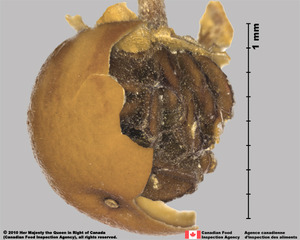 (soft or hard-shelled, referred to as a pomepome:
(soft or hard-shelled, referred to as a pomepome:
an indehiscent, fleshy fruit with accessory floral tube tissue adnate to the pericarp, outer wall thick and fleshy, interior contains papery or cartilaginous structures enclosing the seeds, derived from a single, inferior, compound ovary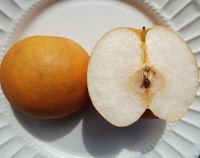 ), rarely a samarasamara:
), rarely a samarasamara:
a winged, indehiscent, dry fruit containing a single (rarely two) seed(s)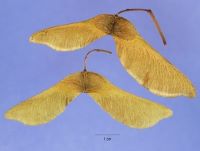 (Sicyos spp.) or acheneachene:
(Sicyos spp.) or acheneachene:
a dry, indehiscent, one-seeded fruit, with seed attached to pericarp at a single point, derived from a single, superior, simple or compound, one-loculed ovary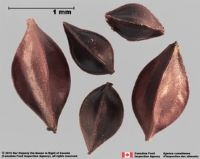 (e.g. Sicydium spp.), sometimes a dry or fleshy capsule. Fruits 10–600 mm long, variably shaped, compressedcompressed:
(e.g. Sicydium spp.), sometimes a dry or fleshy capsule. Fruits 10–600 mm long, variably shaped, compressedcompressed:
flattened; in grasses, used to denote compression (not necessarily flattened) either laterally or dorsiventrally
or tereteterete:
approximately circular in cross section; width and thickness approximately equal
 in transection, rarely rostrate (Trochomeria) or winged (Momordica, Pteropepon), usually with many seeds. Pericarppericarp:
in transection, rarely rostrate (Trochomeria) or winged (Momordica, Pteropepon), usually with many seeds. Pericarppericarp:
fruit wall or fruit coat
often brightly colored and striped or spotted, usually fleshy, fibrousfibrous:
texture -- long, flexible threads, thicker than hairs, that densely cover and obscure the surface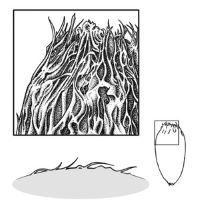 , pulpy or watery surrounded by thick, firm or woodywoody:
, pulpy or watery surrounded by thick, firm or woodywoody:
texture—consisting mainly of indurate lignified tissues, characteristic of or resembling wood
wall, glabrousglabrous:
without hairs
or pubescentpubescent:
surface relief—bearing hairs
, if hairy often densely so, with soft bristles or glandularglandular:
surface relief—covered with small, raised secretory glands, regular or irregularly shaped, translucent or opaque, and maybe distinctly colored hairs. Pericarppericarp:
hairs. Pericarppericarp:
fruit wall or fruit coat
usually ornamented, including with spines, barbs, pustules, or warts.
Seeds globoseglobose:
3D shape—more or less spherical to reniformreniform:
to reniformreniform:
2D or 3D shape—kidney-shaped , often with one or two bulges on each side of the hilahilum:
, often with one or two bulges on each side of the hilahilum:
on seeds, the scar indicating where the funiculus was attached; on grass caryopses, the scar visible on the outer fruit surface revealing where the seed is attached on the inner fruit wall surface; or in Asteraceae cypselae, the scar visible on the outer fruit wall revealing where the fruit was attached to the receptacle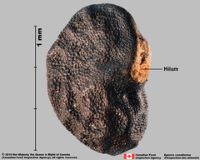 , usually flattened, sometimes lenticularlenticular:
, usually flattened, sometimes lenticularlenticular:
3D shape—lens-shaped; biconvex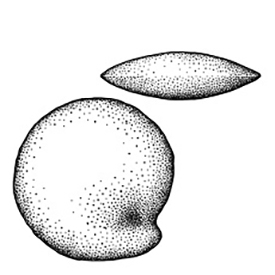 or plano-convex (tereteterete:
or plano-convex (tereteterete:
approximately circular in cross section; width and thickness approximately equal
 in berriesberry:
in berriesberry:
an indehiscent, fleshy fruit with one or a few to many seeds. The flesh may be homogenous throughout. Or, if the outer part is hard, firm, or leathery, referred to as an hesperidium. Septa are present in some, and the seeds may be arillate or with a fleshy testa. ) in transection, with or without thickened margins, 2–60 mm long. Winged or not, see below. Arils derived from placental tissue and often present in fleshy fruits and surround seeds. ArilsAril:
) in transection, with or without thickened margins, 2–60 mm long. Winged or not, see below. Arils derived from placental tissue and often present in fleshy fruits and surround seeds. ArilsAril:
(broad sense) appendicular structure that wholly or partly envelops a seed and is produced from or a modification of the funicle, raphe, or outer integument; usually fleshy or pulpy, sometimes spongy or tufted-capillate, often brightly colored translucent (Cucumis), green (Cucurbitella), red, yellow, or white (Momordica). Seed coat black, brown (all shades), gray, green, yellow, cream-colored, white, or often multicolored or striped, dulldull:
translucent (Cucumis), green (Cucurbitella), red, yellow, or white (Momordica). Seed coat black, brown (all shades), gray, green, yellow, cream-colored, white, or often multicolored or striped, dulldull:
reflecting only a low proportion of incident light, with no apparent sheen , usually with a thick, woodywoody:
, usually with a thick, woodywoody:
texture—consisting mainly of indurate lignified tissues, characteristic of or resembling wood
(or bonybony:
very hard and rather brittle, like bone
) outer wall and paperypapery:
texture—papyraceous, chartaceous; very thin, pliable, and readily torn; like paper
inner wall, glabrousglabrous:
without hairs
or pubescentpubescent:
surface relief—bearing hairs
, if hairy sometimes densely so. Seed coat usually smooth, sometimes groovedgrooved:
surface relief—linear depressions that may be single or form a series of grooves over the surface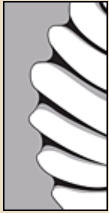 , wrinkledwrinkled:
, wrinkledwrinkled:
surface relief—shallow, irregular folds and furrows covering the surface; appearing overall though crumpled and then spread out , pittedpitted:
, pittedpitted:
surface relief—surface with small depressions in which the areas between the hollows do not take on the appearance of a true reticular net , striatestriate:
, striatestriate:
surface relief—having fine, parallel lines, grooves or ridges , pustulatepustular:
, pustulatepustular:
surface relief—with small blisters or pustules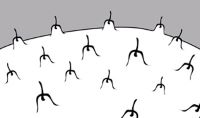 , or wartywarty:
, or wartywarty:
surface relief—distinct, rounded projections that are large relative to the fruit size; tuberculate, verrucose . Seeds in one-seeded fruits often with thin seed coats. HilaHilum:
. Seeds in one-seeded fruits often with thin seed coats. HilaHilum:
on seeds, the scar indicating where the funiculus was attached; on grass caryopses, the scar visible on the outer fruit surface revealing where the seed is attached on the inner fruit wall surface; or in Asteraceae cypselae, the scar visible on the outer fruit wall revealing where the fruit was attached to the receptacle inconspicuous.
inconspicuous.
Genera with winged seeds
Fleshy fruits: winged (Cyclanthera p.p.)
Dry fruits: membranousmembranous:
texture—extremely thin, pliable, and fairly tough
unilateral wings (Gerrardanthus, to 20 mm long, Neoalsomitra spp.), bilateral wings (Siolmatra) or peripheralperipheral:
(of embryo) embryo is curved around the outer edge of the seed, near the seed coat
wing (Bayabusua, to 50 mm in diam.); woodywoody:
texture—consisting mainly of indurate lignified tissues, characteristic of or resembling wood
peripheralperipheral:
(of embryo) embryo is curved around the outer edge of the seed, near the seed coat
wing (most species of Hemsleya), uniform in width; leatheryleathery:
texture—moderately thick, tough, and very pliable
unilateral wing (Zanonia, to 80 mm), narrowly winged (Gynostemma spp., Indofevillea, Neoalsomitra spp.); membranousmembranous:
texture—extremely thin, pliable, and fairly tough
wing, laterally expanded, butterfly-like to 120 mm wide (Alsomitra); strongly winged (Diplocyclos).
Embryo well developed, green or not, completely or nearly filling seed coat, parallel to seed length, foliatefoliate:
appearing leaf-like
, straight, cotyledons well developed and large.
Endosperm trace.
| Fruit | |
| Type | berryberry: an indehiscent, fleshy fruit with one or a few to many seeds. The flesh may be homogenous throughout. Or, if the outer part is hard, firm, or leathery, referred to as an hesperidium. Septa are present in some, and the seeds may be arillate or with a fleshy testa.  , capsulecapsule: , capsulecapsule:a dry, dehiscent fruit derived from a compound ovary  , rarely samarasamara: , rarely samarasamara:a winged, indehiscent, dry fruit containing a single (rarely two) seed(s)  or acheneachene: or acheneachene:a dry, indehiscent, one-seeded fruit, with seed attached to pericarp at a single point, derived from a single, superior, simple or compound, one-loculed ovary  |
| Size range | 10–600 mm long |
| Shape(s) | globoseglobose: 3D shape—more or less spherical  , ellipsoidellipsoid: , ellipsoidellipsoid:3D shape—elliptic , fusiformfusiform: spindle-shaped; broadest at the middle and tapering at both ends 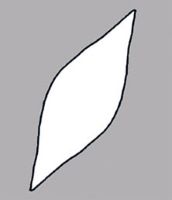 , ovoidovoid: , ovoidovoid:3D shape—ovate  , conicalconical: , conicalconical:3D shape—cone-shaped, with the point of attachment at the broad end 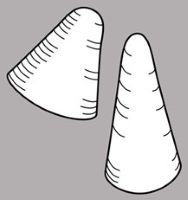 , pear-shaped, turbinateturbinate: , pear-shaped, turbinateturbinate:3D shape—broadly obovoid-obconic , claviformclaviform: 3D shape—club-shaped , cylindricalcylindrical: 3D shape—a cylinder, with parallel sides and a circular cross-section; tubular or rod-shaped , oblongoblong: 2D shape—much longer than broad with nearly parallel sides, corners are rounded  , bottle-shaped, trigonoustrigonous: , bottle-shaped, trigonoustrigonous:3D shape—having three faces that meet at distinct angles; triangular in outline , reniformreniform: 2D or 3D shape—kidney-shaped  , ± asymmetrically marsupiform , ± asymmetrically marsupiform |
| Texture | fleshy, fibrousfibrous: texture -- long, flexible threads, thicker than hairs, that densely cover and obscure the surface  , pulpy, with thick or thin firm or woodywoody: , pulpy, with thick or thin firm or woodywoody:texture—consisting mainly of indurate lignified tissues, characteristic of or resembling wood epicarpepicarp: outer layer of fruit wall or pericarp, if divided into layers; note here used synonymously with exocarp 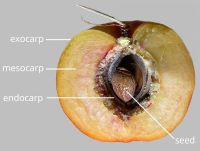 |
| Surface relief | smooth, 6–12 groovedgrooved: surface relief—linear depressions that may be single or form a series of grooves over the surface  , ribbedribbed: , ribbedribbed:surface relief—wide, prominent, linear ridges that are generally rounded and longitudinally situated on the surface  , pittedpitted: , pittedpitted:surface relief—surface with small depressions in which the areas between the hollows do not take on the appearance of a true reticular net  , echinate, barbedbarbed: , echinate, barbedbarbed:(of awns or bristles) with short, sharp, hair-like projections , wartywarty: surface relief—distinct, rounded projections that are large relative to the fruit size; tuberculate, verrucose  , spinyspiny: , spinyspiny:having slender, stiff, sharp projections oriented in the general plane of the structure  , pustularpustular: , pustularpustular:surface relief—with small blisters or pustules  |
| Color(s) | black, brown, yellow, orange, red, green, purple, often with stripes or spots, rarely metallic blue |
| Unique features | Usually brightly colored, firm-walled berriesberry: an indehiscent, fleshy fruit with one or a few to many seeds. The flesh may be homogenous throughout. Or, if the outer part is hard, firm, or leathery, referred to as an hesperidium. Septa are present in some, and the seeds may be arillate or with a fleshy testa.  with large, numerous, thick walled, flattened, sometimes winged seeds. with large, numerous, thick walled, flattened, sometimes winged seeds. |
| Seed | |
| Size range | 2–60 mm long |
| Shape(s) | globoseglobose: 3D shape—more or less spherical  , ellipsoidellipsoid: , ellipsoidellipsoid:3D shape—elliptic , fusiformfusiform: spindle-shaped; broadest at the middle and tapering at both ends  , linearlinear: , linearlinear:(shape) long, narrow, and uniform in width; (of embryo) embryo is straight and much longer than wide  , oblongoblong: , oblongoblong:2D shape—much longer than broad with nearly parallel sides, corners are rounded  , falcatefalcate: , falcatefalcate:shaped like a scythe or sickle  , ovoidovoid: , ovoidovoid:3D shape—ovate  , pear-shaped, angularangular: , pear-shaped, angularangular:2D shape—having sides that meet at acute or obtuse angles , ± turtle-shaped, horned or starshaped, reniformreniform: 2D or 3D shape—kidney-shaped  |
| Surface relief | smooth, groovedgrooved: surface relief—linear depressions that may be single or form a series of grooves over the surface  , wrinkledwrinkled: , wrinkledwrinkled:surface relief—shallow, irregular folds and furrows covering the surface; appearing overall though crumpled and then spread out  , pittedpitted: , pittedpitted:surface relief—surface with small depressions in which the areas between the hollows do not take on the appearance of a true reticular net  , striatestriate: , striatestriate:surface relief—having fine, parallel lines, grooves or ridges  , pustulatepustular: , pustulatepustular:surface relief—with small blisters or pustules  , wartywarty: , wartywarty:surface relief—distinct, rounded projections that are large relative to the fruit size; tuberculate, verrucose  |
| Color(s) | black, brown (all shades), gray, green, yellow, cream-colored, white, often multicolored or striped |
| Unique features | Usually large, flattened seeds, often brightly or multicolored, with thick, woodywoody: texture—consisting mainly of indurate lignified tissues, characteristic of or resembling wood seed coats and well-developed, foliatefoliate: appearing leaf-like embryos filling nearly the entire seed coat. Seeds sometimes winged. Brightly colored aril-like tissue surround seeds in some genera. |
| Other | |
| Embryo | well developed, green or not, completely or nearly filling seed coat, parallel to seed length, foliatefoliate: appearing leaf-like , straight, cotyledons well developed and large |
| Nutritive tissue | endosperm trace |
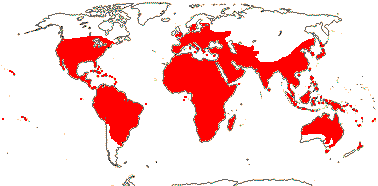
Distribution map courtesy of Angiosperm Phylogeny Website.
Kirkbride et al. 2006Kirkbride et al. 2006:
Kirkbride JH, Jr, Gunn CR, and Dallwitz MJ. 2006. Family guide for fruits and seeds, vers. 1.0. Accessed September 2020-January 2022. URL: https://nt.ars-grin.gov/seedsfruits/keys/frsdfam/index.cfm .; Kubitzki et al. 1990+Kubitzki et al. 1990+:
Kubitzki K et al., eds. 1990+. The families and genera of vascular plants. 7+ vols. Berlin etc.; Schaefer 2020Schaefer 2020:
Schaefer H. 2020. Cucurbit Website. www.cucurbit.de. Version 1, January 2020.; USDA 1980USDA 1980:
United States Dept. of Agriculture (USDA). 1980. Major weed family identification guide. Hyattsville Md, United States ; Takhtajan 2009Takhtajan 2009:
Takhtajan A. 2009. Flowering plants: Second edition. Springer Nature, Switzerland. 871 pp.
*The number of genera and species is based on Christenhusz and Byng 2016Christenhusz and Byng 2016:
Christenhusz MJM and Byng JW. 2016. The number of known plant species in the world and its annual increase. Phytotaxa 261 (3): 201-217. https://doi.org/10.11646/phytotaxa.261.3.1, which may differ from the number of genera in GRIN-Global.